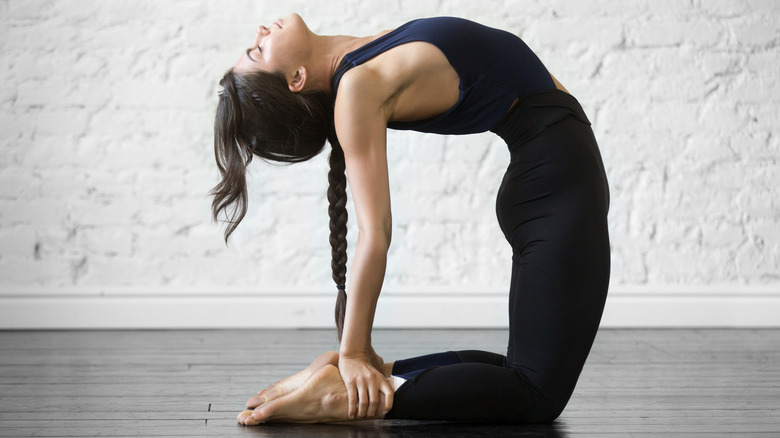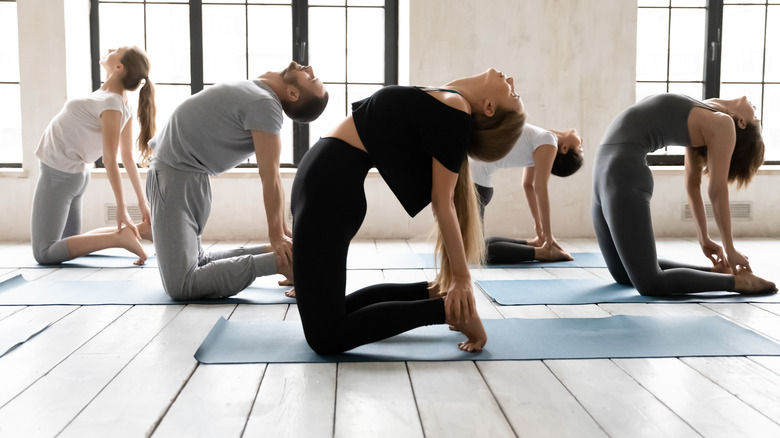The Benefits Of Doing Camel Pose In Yoga
Yoga has become increasingly popular in recent years, not just as a form of exercise, but as a way of life. Originally developed in ancient India as a spiritual practice, yoga has evolved into a mainstream form of exercise and wellness practiced by millions worldwide. According to a 2016 survey by Yoga Journal and Yoga Alliance, over 36 million people in the United States practice yoga regularly. Another 2021 study published in the Journal of Alternative and Complementary Medicine notes that the prevalence of yoga practice among U.S. adults rose from 5.1% in 2002 to 13.7% in 2017.
One possible reason for the popularity of yoga is its stress-relieving capabilities. Yoga incorporates deep breathing, meditation, and physical movement, which can help you manage stress and improve your overall wellbeing, says Healthline. Yoga can also be practiced by people of all ages, fitness levels, and abilities, and can be adapted to meet individual needs and goals. Generally speaking, it is a versatile exercise with many different styles available, from gentle and restorative to vigorous and athletic — you can choose a practice that best suits your preferences and fitness levels.
If you are looking for a versatile yoga pose that can be easily adapted to meet your individual needs, then the camel pose, also known as Ustrasana, is a great one to try. This popular yoga pose offers numerous benefits to the body.
Benefits of practicing camel pose
Camel pose can work as an effective stretch for the back, core, hip flexors, and legs, as Yogic-Experience notes. As such, it's unsurprising that it may be recommended for those with lower back pain – though it's important to note that those with back or neck injuries or who have a herniated disc should avoid the pose (via WebMD). The camel pose may also help to improve your posture. The deep backbend of the camel pose stretches the spine, which can help strengthen the back muscles and encourage a more upright position, says the BioSpine Institute.
While camel pose is primarily known for its benefits for the back, spine, and core muscles, it can also have an impact on the thyroid gland and blood circulation, says Healthline. The thyroid gland is shaped like a butterfly and is found in the neck, per Cleveland Clinic. It helps regulate metabolism and energy levels in the body. When the thyroid gland is not functioning properly, it can lead to a range of health issues, including weight gain or loss, fatigue, and dry hair.
Beyond its physical benefits, yoga is generally good for promoting mental wellbeing — it can help improve metabolism and circulatory health and increase muscle tone and strength, per the American Osteopathic Association. The increased flexibility gained from the practice can also help improve overall mobility (via Healthline).
How to practice the camel pose
To practice camel pose, WebMD advises to begin by kneeling on your mat with your knees hip-width apart and your hands on your hips. Make sure that your palms are placed on your tailbone. From here, press your hips forward and engage your core muscles as you lift your chest and arch your back. Keep your hands on your tailbone for support. If you feel comfortable, remove your hands from your tailbone and gently bring your hands to your heels, one hand at a time. Come out of the pose slowly by releasing your hands from your heels and bringing them back to your lower back. Use your core muscles to lift your chest and bring your torso back to an upright position. Finish the pose by sitting back on your heels and taking a few deep breaths.
If you experience any pain or discomfort in camel pose, come out of it slowly and gently. It may be best to consult with a yoga practitioner to ensure you're performing the pose correctly. An instructor will also be able to suggest modifications to camel pose or alternate poses to suit your individual needs.



